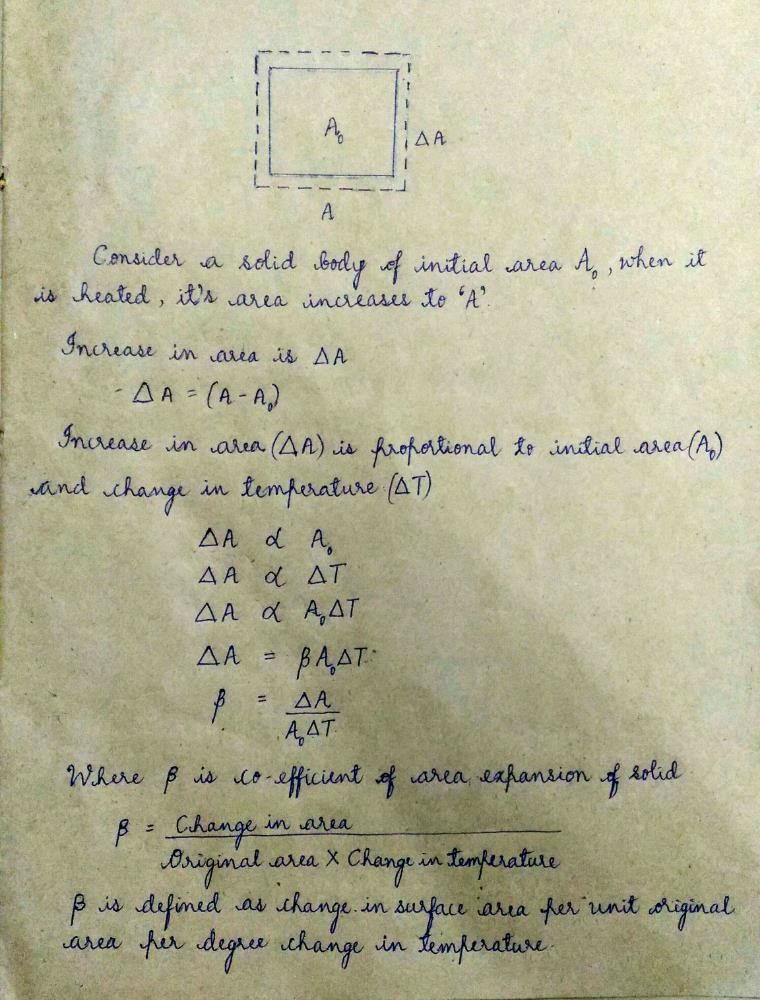Class 11 Exam > Class 11 Questions > Derive the expression of the coefficient of a...
Start Learning for Free
Derive the expression of the coefficient of areal expansion in solid ?
Most Upvoted Answer
Derive the expression of the coefficient of areal expansion in solid ?

Community Answer
Derive the expression of the coefficient of areal expansion in solid ?
Derivation of the Coefficient of Areal Expansion in Solids
Introduction
The coefficient of areal expansion is a measure of the change in area of a solid per unit change in temperature. It is denoted by the symbol α. The coefficient of areal expansion is important in engineering and physics as it allows us to predict how a material will change in size with temperature variations.
Formula
The formula for the coefficient of areal expansion is given by:
α = (1/A) (dA/dT)
where A is the original area of the solid, dA is the change in area of the solid due to a change in temperature dT.
Explanation
The coefficient of areal expansion can be derived using the relationship between linear expansion and area expansion. The linear expansion coefficient is denoted by the symbol β and is a measure of the change in length per unit change in temperature. The formula for linear expansion is given by:
ΔL = L0 β ΔT
where ΔL is the change in length, L0 is the original length, β is the linear expansion coefficient, and ΔT is the change in temperature.
The change in area of the solid due to a change in temperature can be expressed in terms of linear expansion as:
ΔA = L0 ΔL + (ΔL)^2
Substituting the value of ΔL from the linear expansion formula, we get:
ΔA = L0 β ΔT + (β ΔT)^2
Using the binomial expansion formula, we can simplify this expression to:
ΔA = L0 β ΔT (1 + β ΔT/L0)
Dividing both sides by the original area A, we get:
dA/A = β ΔT (1 + β ΔT/L0)
Taking the limit as ΔT approaches zero, we get:
dA/dT = β (1 + β ΔT/L0)
Dividing both sides by the original area A, we get:
α = (1/A) (dA/dT) = β (1 + β ΔT/L0)/A
Simplifying this expression, we get:
α = β (1 + α β)
Solving for α, we get:
α = β/(1 - α β)
Conclusion
In conclusion, the coefficient of areal expansion in solids can be derived from the linear expansion coefficient by using the relationship between linear expansion and area expansion. The coefficient of areal expansion is important in predicting how a material will change in size with temperature variations and is used in engineering and physics applications.
Attention Class 11 Students!
To make sure you are not studying endlessly, EduRev has designed Class 11 study material, with Structured Courses, Videos, & Test Series. Plus get personalized analysis, doubt solving and improvement plans to achieve a great score in Class 11.

|
Explore Courses for Class 11 exam
|

|
Similar Class 11 Doubts
Derive the expression of the coefficient of areal expansion in solid ?
Question Description
Derive the expression of the coefficient of areal expansion in solid ? for Class 11 2024 is part of Class 11 preparation. The Question and answers have been prepared according to the Class 11 exam syllabus. Information about Derive the expression of the coefficient of areal expansion in solid ? covers all topics & solutions for Class 11 2024 Exam. Find important definitions, questions, meanings, examples, exercises and tests below for Derive the expression of the coefficient of areal expansion in solid ?.
Derive the expression of the coefficient of areal expansion in solid ? for Class 11 2024 is part of Class 11 preparation. The Question and answers have been prepared according to the Class 11 exam syllabus. Information about Derive the expression of the coefficient of areal expansion in solid ? covers all topics & solutions for Class 11 2024 Exam. Find important definitions, questions, meanings, examples, exercises and tests below for Derive the expression of the coefficient of areal expansion in solid ?.
Solutions for Derive the expression of the coefficient of areal expansion in solid ? in English & in Hindi are available as part of our courses for Class 11.
Download more important topics, notes, lectures and mock test series for Class 11 Exam by signing up for free.
Here you can find the meaning of Derive the expression of the coefficient of areal expansion in solid ? defined & explained in the simplest way possible. Besides giving the explanation of
Derive the expression of the coefficient of areal expansion in solid ?, a detailed solution for Derive the expression of the coefficient of areal expansion in solid ? has been provided alongside types of Derive the expression of the coefficient of areal expansion in solid ? theory, EduRev gives you an
ample number of questions to practice Derive the expression of the coefficient of areal expansion in solid ? tests, examples and also practice Class 11 tests.

|
Explore Courses for Class 11 exam
|

|
Suggested Free Tests
Signup for Free!
Signup to see your scores go up within 7 days! Learn & Practice with 1000+ FREE Notes, Videos & Tests.

























